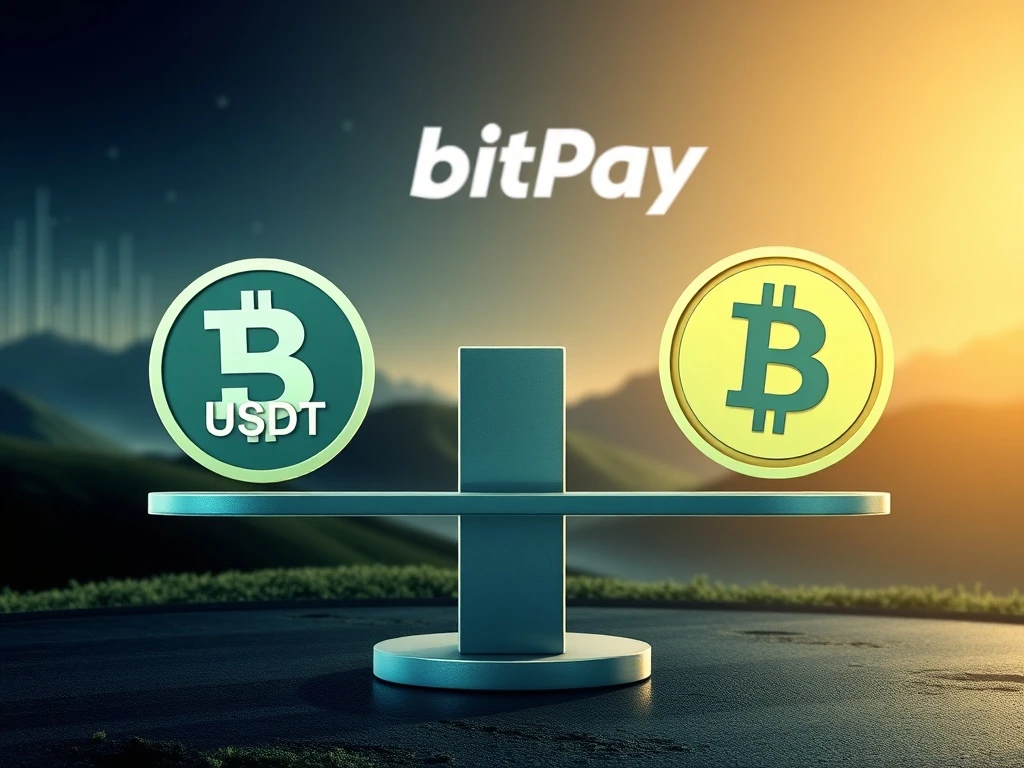Tether USDT’s Stunning Ascent: Narrowing USDC’s Lead in BitPay Payments by 2025

The landscape of cryptocurrency payments is undergoing a fascinating transformation. For a considerable period, Circle’s USDC stablecoin held a dominant position on major platforms like BitPay. However, recent data from 2025 reveals a remarkable shift: Tether USDT is rapidly closing the gap, challenging USDC’s long-standing lead in BitPay payments. This shift signals a crucial evolution in how digital assets are utilized for everyday transactions.
The Shifting Dynamics of BitPay Payments
In 2024, USDC’s dominance on BitPay was clear. It accounted for a substantial 85% of stablecoin transactions, while USDT held a mere 13%. Fast forward to May 2025, and the picture looks very different. The balance has shifted considerably in favor of Tether.
- January 2024: USDC’s transaction share on BitPay was 85%, compared to USDT’s 13%.
- May 2025: USDC’s share dropped to 56%, while USDT grew to 43% of payments.
This narrowing gap is particularly notable given the optimism surrounding Circle’s public launch in early June and certain regulatory advantages it holds, especially under the European Union’s Markets in Crypto-Assets Regulation (MiCA).
Tether USDT’s Growing Dominance in Transaction Volume
Beyond just transaction count, Tether USDT has also taken the lead in payment volume on BitPay. While USDC was the most commonly used token in 2024, a significant change occurred in 2025.
BitPay reported that starting in March 2025, USDT gained a sizable share of transaction volume, exceeding 70% of the total stablecoin volume processed by the platform. This indicates that not only are more people using USDT for payments, but they are also transacting larger amounts with it.
According to BitPay, this shift can be attributed to two main factors: a growth in overall stablecoin transactions and a swing in existing merchants and customers preferring USDT over USDC. BitPay’s chief revenue officer, Bill Zielke, noted the platform’s sizable user and merchant base in Europe, alongside its focus on growth in the United States.
Understanding the USDC Stablecoin’s Position
Despite the observed decline in its transaction share on BitPay, the USDC stablecoin continues to exhibit notable growth in its overall market capitalization. This presents an interesting paradox: losing ground in specific payment platform usage while still expanding its total market presence.
- Market Cap Growth: USDC’s market cap surged by 88% in the past year, from approximately $33 billion to $61.7 billion.
- Year-to-Date Growth: USDC’s market cap increased by 41% year-to-date.
This continued market cap expansion for USDC suggests that its utility and adoption extend beyond just direct payments on platforms like BitPay, potentially encompassing DeFi, institutional use, or other areas where its regulatory clarity is valued.
Strategic Divergence: Stablecoin Market Approaches
The contrasting performance on BitPay, alongside the differing growth in market capitalization, offers insight into the divergent strategies of Tether and Circle within the broader stablecoin market. Circle has actively pursued regulatory compliance, becoming the first global stablecoin issuer to receive regulatory approval under Europe’s MiCA in July 2024. Furthermore, Circle debuted public trading on June 5, after a successful $1.05 billion offering.
In stark contrast, Tether has openly criticized certain aspects of MiCA regulation, explicitly refusing to comply with the framework in Europe. Tether CEO Paolo Ardoino also confirmed in June that Tether has no intention of pursuing an initial public offering. This fundamental difference in approach to regulation and corporate structure seems to be influencing user and merchant preferences on platforms like BitPay.
What This Means for Crypto Transactions and Market Share
The data from BitPay provides a granular view of how user preferences for crypto transactions are evolving. While USDC maintains its overall market capitalization growth, the shift in transaction count and volume on a key payment platform like BitPay indicates a growing preference for Tether USDT among active users and merchants engaging in direct payments.
This dynamic competition highlights the multifaceted nature of the stablecoin ecosystem. It’s not just about market cap; it’s also about practical utility, regulatory comfort, and regional preferences. Businesses and individuals engaged in crypto payments should pay close attention to these trends to optimize their operations and choices.
Conclusion: A New Chapter in Stablecoin Dominance
The remarkable shift observed on BitPay in 2025, with Tether USDT significantly narrowing the lead of USDC stablecoin in transaction counts and outright dominating in payment volume, marks a pivotal moment. This trend, driven by both overall growth in crypto transactions and a clear preference swing, underscores the evolving dynamics of the stablecoin market. Despite Circle’s regulatory advantages and public listing, Tether’s strategic choices and market acceptance are proving highly effective in the payment processing arena. This ongoing competition promises to shape the future of digital payments, offering users and businesses more diverse and robust options for their crypto needs.








